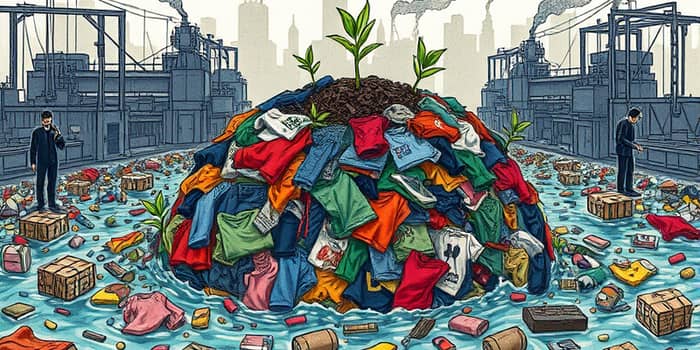Every season, millions of garments flood store shelves, enticing shoppers with low prices and the promise of staying on-trend. But behind the allure of new styles lies a hidden ledger of environmental destruction, social injustice, and cultural decay. Understanding this ledger is the first step toward reclaiming our power as consumers.
Origins and Emergence of Fast Fashion
Fast fashion emerged in the early 1990s when brands like Zara pioneered a rapid design-to-store cycle of just 15 days. This breakthrough model allowed retailers to churn out imitations of high-end runway looks at lightning speed. Major players—H&M, Forever 21, UNIQLO, Shein—followed suit, democratizing style but sacrificing quality and ethics.
The term itself captures a critical truth: clothing that is made cheaply and sold quickly breeds a culture of endless consumption. As design cycles shrank from months to weeks, consumers adapted, buying more, discarding sooner, and perpetuating a never-ending demand for low-cost fashion.
Environmental Devastation
Fast fashion’s environmental toll is staggering. The industry accounts for approximately 10% of global carbon emissions—surpassing all international flights and maritime shipping combined. Textile production alone emits 1.2 billion tons of greenhouse gases each year, a figure projected to rise 50% by 2030 without intervention.
Water scarcity intensifies the crisis. Producing a single cotton shirt demands around 2,700 liters of water. Annually, the fashion sector consumes 93 billion cubic meters—enough water to sustain five million people. Globally, the entire industry guzzles 141 billion cubic meters.
Pollution follows every rinse: untreated chemicals from dyeing processes contribute 20% of the world’s wastewater. Synthetic fibers add to marine distress, shedding 500,000 tons of microplastics into oceans each year—equivalent to 50 billion plastic bottles.
- 92 million tonnes of textile waste landfilled annually.
- 85% of all textiles become waste within a year.
- 35% of ocean microplastics come from polyester, acrylic, and nylon.
Human Toll: Labor and Exploitation
Beyond environmental harm, fast fashion thrives on reliance on cheap, exploitative labor in developing countries. Factories operate under lax regulations, pushing workers—often women—to extremes. Reports reveal Shein employees clocking 18-hour days, earning as little as $0.04 per garment, with only one day off per month.
Excessive hours—sometimes exceeding 120 per week—lead to chronic health issues, mental strain, and little hope for advancement. The human cost is a silent ledger, masked by bargain-bin prices and vibrant advertising campaigns.
The Culture of Disposability
Fast fashion conditions us to treat clothing as ephemeral. When a trend fades, garments are tossed aside, destined for landfills. This cheap, trendy clothes at breakneck pace mentality undermines traditional values of repair, repair, reuse, and respect for craftsmanship.
Major chains introduce new inventory every two to four weeks, fueling a sense of urgency and panic-buying. Social media influencers showcase endless wardrobes, reinforcing the message: you can never have too many outfits.
Economic Drivers and Market Growth
Despite mounting criticism, the fast fashion market shows no signs of slowing. Valued at $150.82 billion in 2025, it is projected to reach $291.1 billion by 2032, growing at a 10.7% CAGR. Doubling clothing production since 2000, the industry profits by appealing to consumers’ desire for variety and low prices.
Yet this growth masks hidden costs paid by the environment and vulnerable workers. As long as cheap garments win over ethical considerations, unchecked expansion will continue.
Paths to Sustainable Change
Consumers wield immense power. By shifting habits and demanding transparency, we can reshape the industry. Here are practical steps to reduce your footprint and foster a more responsible fashion ecosystem:
- Choose quality over quantity—invest in timeless pieces crafted to last.
- Support brands with transparent supply chains and fair labor practices.
- Embrace second-hand shopping, clothing swaps, and rentals.
- Learn basic mending skills to prolong a garment’s life.
- Recycle and upcycle—transform waste into valuable resources through DIY projects or local programs.
Systemic change also requires policy intervention: stricter environmental regulations, enforceable labor standards, and incentives for circular business models. Collective action—from grassroots movements to international treaties—can compel corporations to prioritize people and planet alongside profit.
Summary of Core Metrics
Conclusion: A Call to Conscious Consumption
The true cost of fast fashion extends far beyond sticker prices. It encompasses a devastating environmental footprint worldwide, rampant labor exploitation, and a cultural shift toward waste and disposability. Each purchase is a vote for the kind of world we want.
By choosing garments built to endure, supporting ethical brands, and advocating for systemic reforms, we can reduce the hidden toll of our wardrobes. The journey toward sustainable fashion demands vigilance, creativity, and compassion. Yet every step—no matter how small—brings us closer to a future where style and sustainability coexist in harmony.
References
- https://earth.org/fast-fashions-detrimental-effect-on-the-environment/
- https://www.uniformmarket.com/statistics/fast-fashion-statistics
- https://earth.org/statistics-about-fast-fashion-waste/
- https://carbontrail.net/blog/fast-fashion-and-its-environmental-impact-in-2025/
- https://stateofmatterapparel.com/blogs/som-blog/10-scary-statistics-about-fast-fashion-the-environment
- https://bridgingthegap.org/the-true-cost-of-fast-fashion/
- https://www.plasticcollective.co/how-fast-fashion-is-bad-for-the-environment/
- https://iu.pressbooks.pub/foodfiberfashionfa20/chapter/the-hidden-costs-of-fast-fashion/










